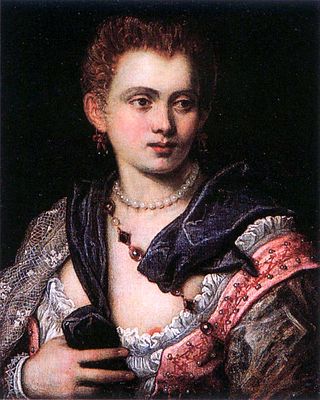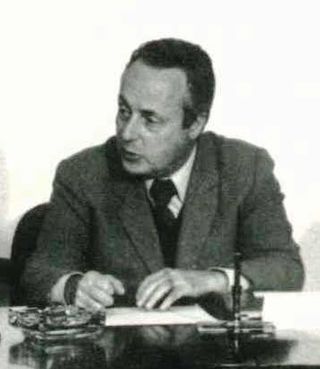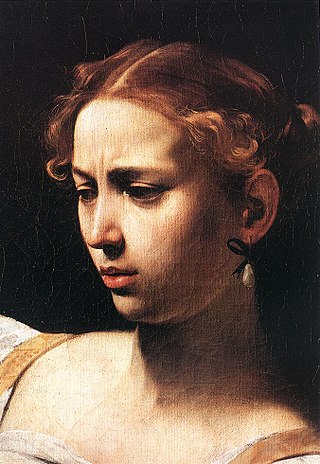Related Research Articles

Michelangelo Merisi da Caravaggio, known mononymously as Caravaggio, was an Italian painter active in Rome for most of his artistic life. During the final four years of his life, he moved between Naples, Malta, and Sicily until his death. His paintings have been characterized by art critics as combining a realistic observation of the human state, both physical and emotional, with a dramatic use of lighting, which had a formative influence on Baroque painting.

The House of Sforza was a ruling family of Renaissance Italy, based in Milan. Sforza rule began with the family's acquisition of the Duchy of Milan following the extinction of the Visconti family in the mid-15th century and ended with the death of the last member of the family's main branch, Francesco II Sforza, in 1535.
A courtesan is a prostitute with a courtly, wealthy, or upper-class clientele. Historically, the term referred to a courtier, a person who attended the court of a monarch or other powerful person.

Veronica Franco (1546–1591) was an Italian poet and courtesan in 16th-century Venice. She is known for her notable clientele, feminist advocacy, literary contributions, and philanthropy. Her humanist education and cultural contributions influenced the roles of Courtesans in the late Venetian Renaissance.

Ludovico Maria Sforza, also known as Ludovico il Moro, and called the "arbiter of Italy" by historian Francesco Guicciardini, was an Italian nobleman who ruled as the Duke of Milan from 1494 to 1499.

Giorgio Bassani was an Italian novelist, poet, essayist, editor, and international intellectual.

Saint Catherine of Alexandria is an oil painting by the Italian Baroque master Caravaggio, painted from 1598-1599. It is part of the Thyssen-Bornemisza Collection of Madrid.

Tullia d'Aragona was an Italian poet, author, and philosopher. Born in Rome sometime between 1501 and 1505, Tullia traveled throughout Venice, Ferrara, Siena, and Florence before returning to Rome. Throughout her life, Tullia was esteemed one of the best female writers, poets, and philosophers of her time. Influencing many of the most famous philosophers, Tullia's work elevated women's status in literature to equal that of men. Her intellect, literary abilities, and social graces helped her become among the most celebrated of Renaissance poet-courtesans.

Antonio Tebaldeo (1463–1537) was an Italian poet. He figured among the writers of the time who engaged in the discussion concerning the nature of literary Italian.

Mara Galassi is an Italian harpist, musicologist and recording artist specializing in the music for Early harps, including Gothic, Renaissance, and Baroque, in particular double (cross-strung) and triple harps of the Renaissance and Baroque eras, as well as Classical era single-action pedal harps.
Maurizio Moro (15??—16??) was an Italian poet of the 16th century, best known for his madrigals.
Roberto Ferri is an Italian artist and painter from Taranto, Italy, who is deeply inspired by Baroque painters and other old masters of Romanticism, the Academy, and Symbolism.
Lucrezia Marinella (1571-1653) was an Italian poet, author, philosopher, polemicist, and women's rights advocate. She is best known for her polemical treatise The Nobility and Excellence of Women and the Defects and Vices of Men (1600). Her works have been noted for bringing women into the philosophical and scientific community during the late Renaissance.

Imperia Cognati, was a Roman courtesan. She has been considered the first celebrity of the class of courtesans, which was created in Rome in the late 15th century.

Lucrezia Borgia is a 1940 Italian historical film directed by Hans Hinrich and starring Isa Pola, Friedrich Benfer and Carlo Ninchi. The film portrays the life of Lucrezia Borgia (1480-1519), one of a number of Italian films of the era set during the Renaissance. It was made at the Scalera Studios in Rome.

Fillide Melandroni was an Italian courtesan and friend of the painter Caravaggio, who used her as a model in several of his compositions.
Lucrezia Di Siena, was an Italian stage actress. She is known as the first identified female actor in Europe since antiquity.
Camilla Pisana was an Italian courtesan, known as a letter writer and poet.

The San Gallo Gate is part of the city walls of Florence and is located in Piazza della Libertà, opposite the Triumphal Arch.
References
- ↑ Jansen, Sharon L. "Veronica Franco, the "Cortigiana onesta" (the "honored courtesan")" . Retrieved 2022-10-18.
- ↑ https://www.liberaeva.com/2022/interviste/beatriceferrarese/beatrice.htm
- ↑ https://www.liberaeva.com/2022/interviste/LucreziaPorzia/lucrezia.htm
- ↑ https://www.liberaeva.com/2022/interviste/BeatricePareggi/BeatricePareggi.htm
- ↑ https://www.liberaeva.com/2022/interviste/ANGELAGRECA/angela.htm
- ↑ iviaggidiraffaella.blogspot.com/2017/02/le-cortigiane-e-le-prostitute-di-roma.html
- ↑ https://www.liberaeva.com/2023/interviste/Angeladelmoro/Angeladelmoro.htm
- ↑ https://www.liberaeva.com/2021/interviste/giulialombardo/giulia.htm